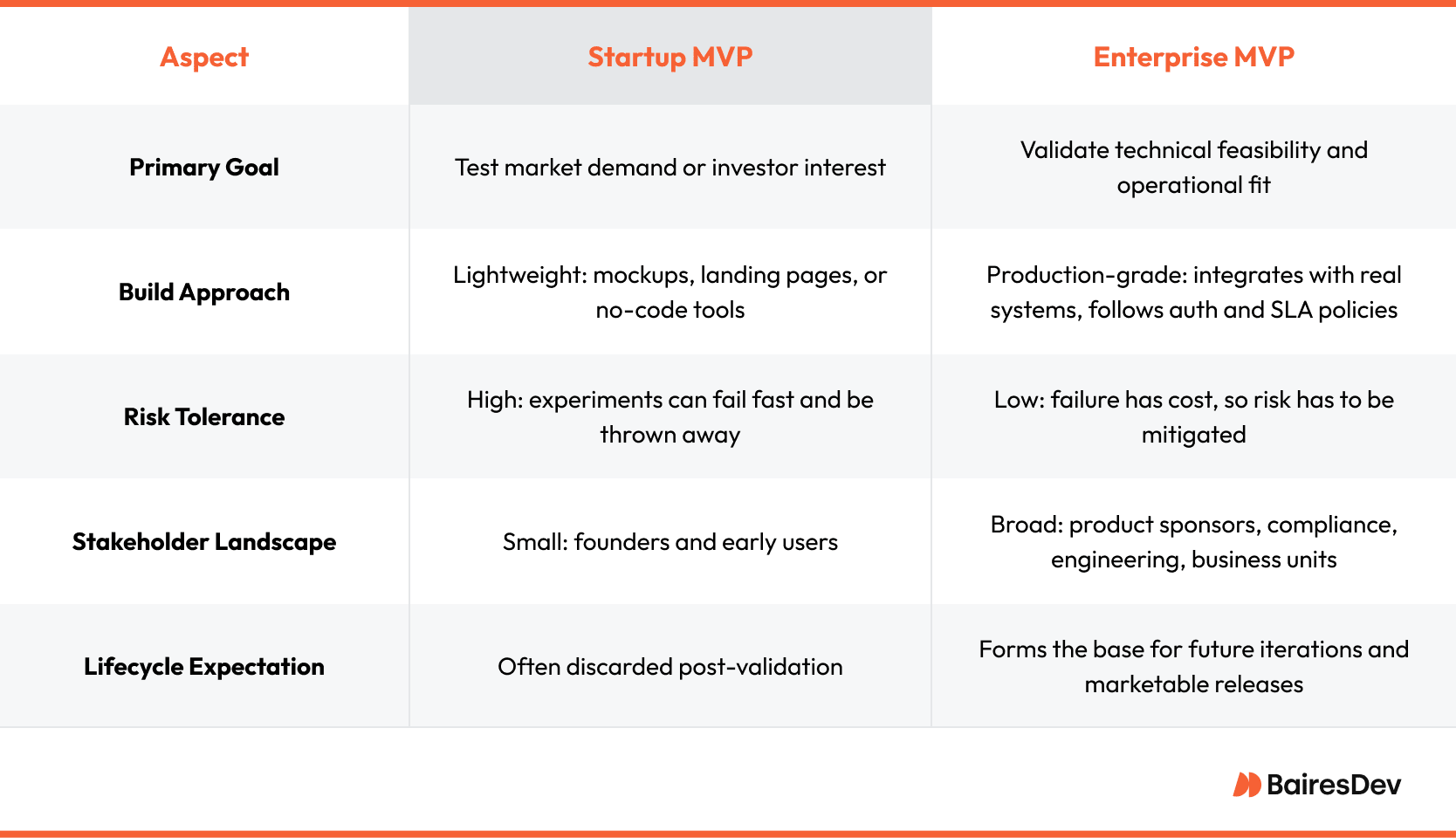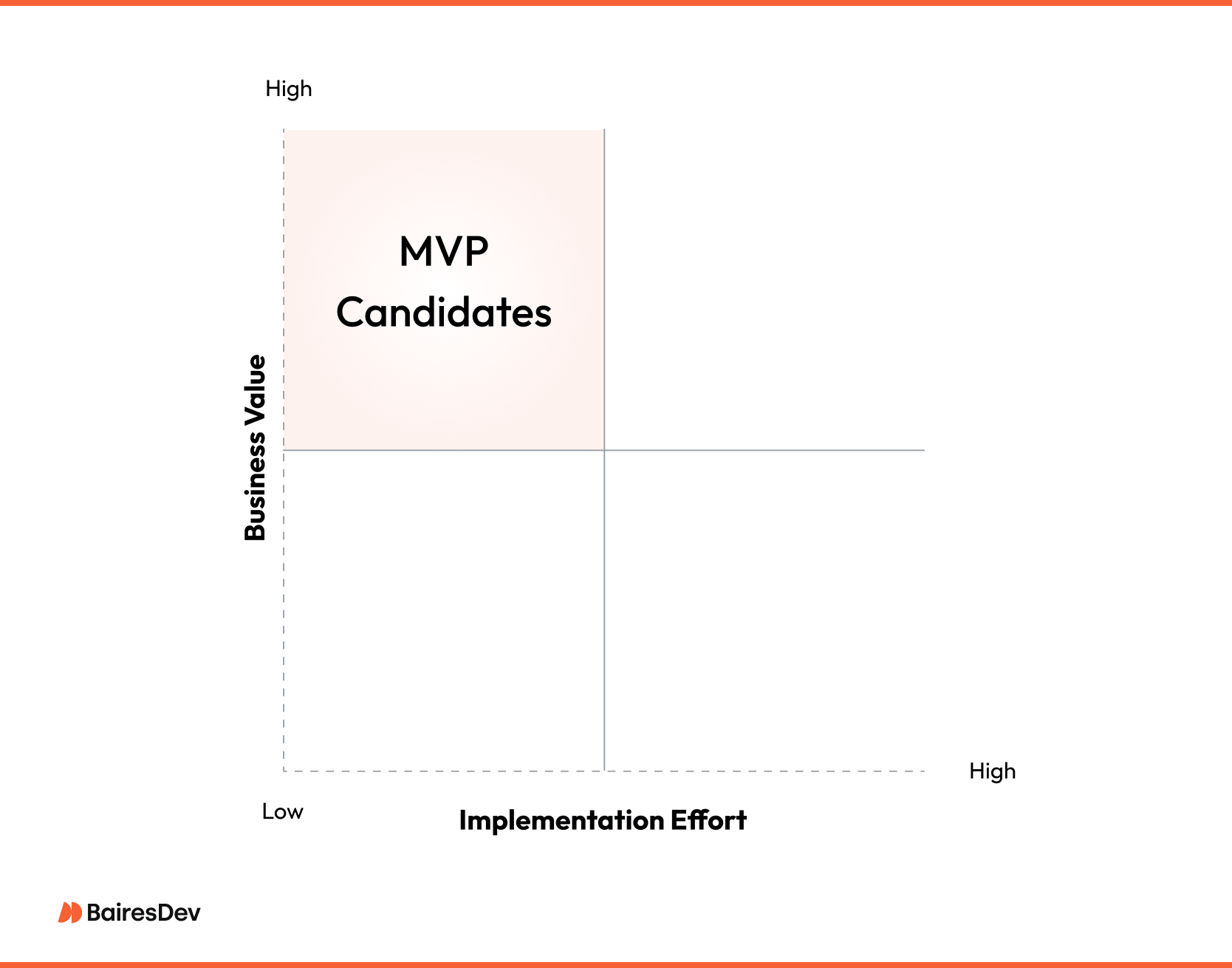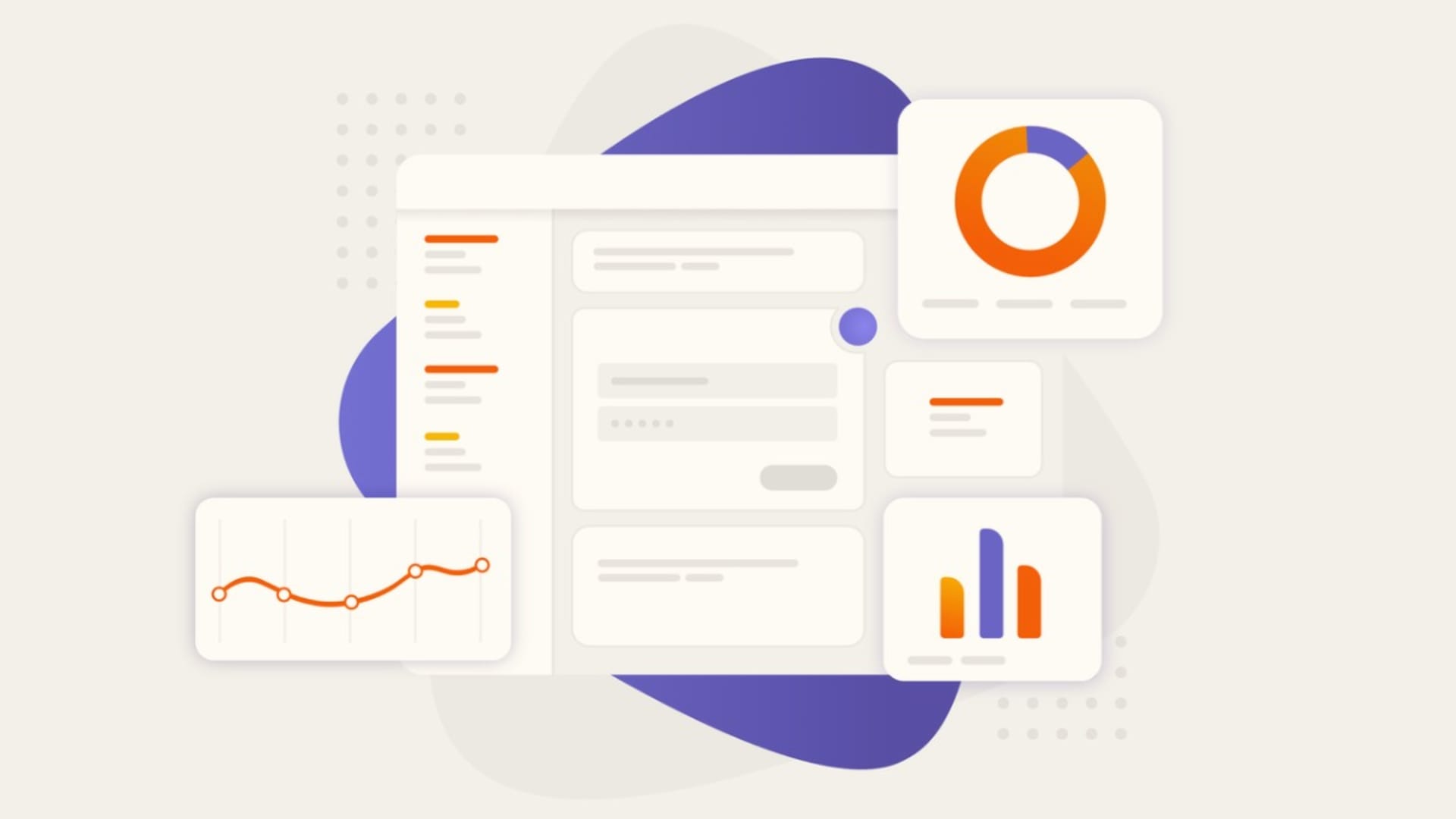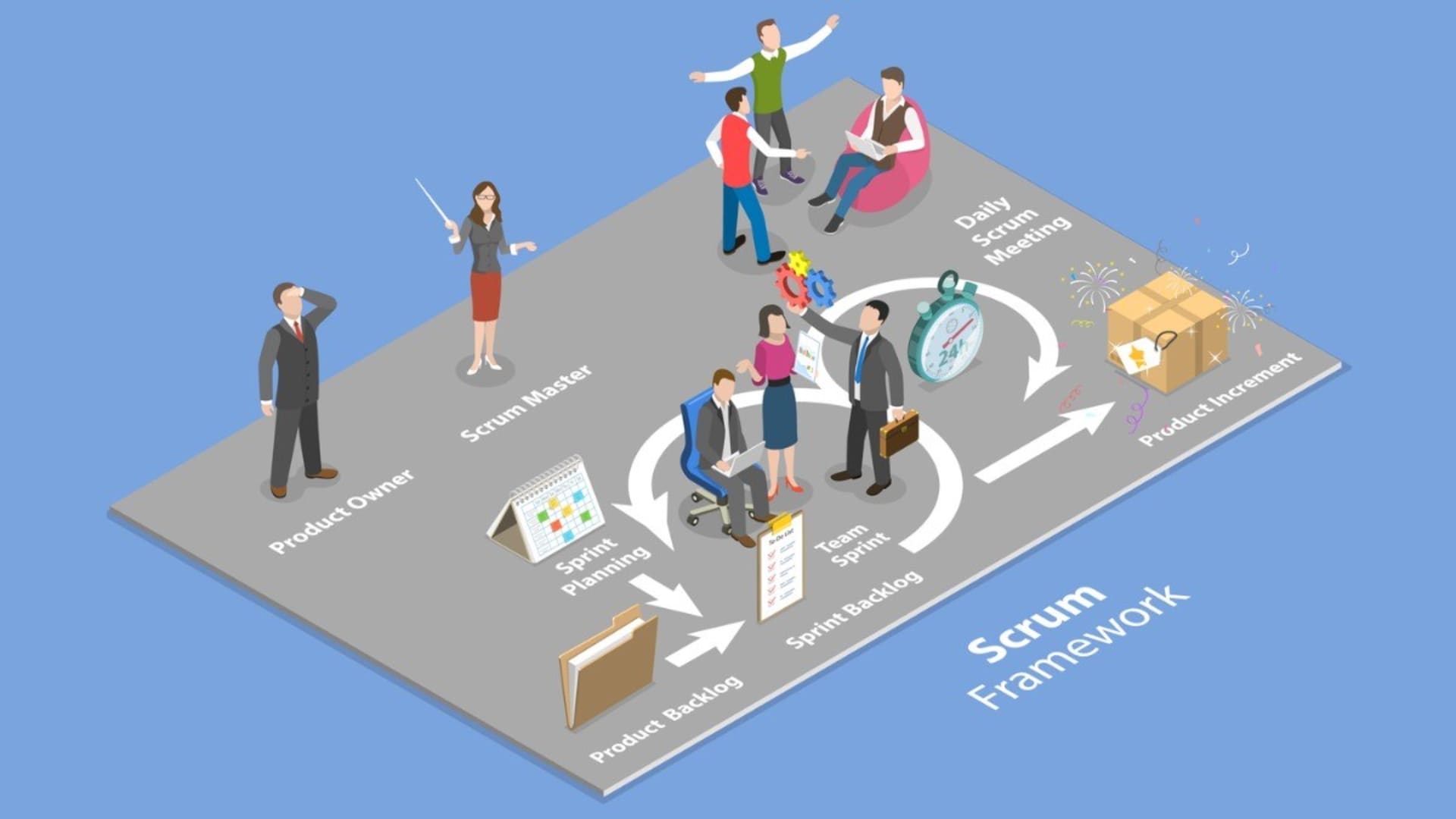Large engineering organizations have no margin for speculative builds; every release must serve a clear purpose. A minimum viable product (MVP) narrows scope to the smallest collection of capabilities that generate trustworthy evidence under real production conditions. It is not a disposable sketch. It must integrate with existing tooling, satisfy baseline security controls, and convince budget owners that the concept deserves a slot on the roadmap.
Picture the platform team rolling out a cross-regional resource-utilization dashboard. Instead of delivering every report, filter, and alert, the team ships one view that focuses on a single, high-value metric. Within days, user feedback expose data-pipeline gaps, permission mismatches, and workflow quirks never mentioned in planning sessions. Those revelations reshape the backlog for the next sprint, protecting engineering capacity and killing untested assumptions.
Inside an enterprise, the MVP functions as a disciplined learning machine, replacing verbose specifications with measurable signals from live traffic. The sections that follow redefine the MVP for mature organizations, differentiate it from the later minimum marketable product (MMP), and explain how tight feedback loops cut risk and accelerate decision making.
The Role of an MVP in Enterprise Product Development
The term MVP often brings to mind scrappy startup teams pushing out quick prototypes to test a simple idea. But in an enterprise environment, the stakes and standards are very different, as is the process of building MVPs.

Defining an MVP for Large Organizations
A seed-stage startup can validate a clickable mock-up, but an enterprise cannot. A legitimate enterprise MVP must pull from at least one live data source, respect identity policies, and meet service-level objectives. The hypothesis may be as focused as proving that a lightweight API handles peak load or that a reduced dashboard cuts reconciliation effort in half.
Anchor the first release on that single hypothesis. Everything else is set aside for future development, e.g., extra filters, custom exports, advanced visualizations, and new features. Treat the MVP as the first genuine production deployment, not an experiment bound for the recycle bin. Solid architecture from the get go positions the minimum viable product for continuous evolution.
From MVP to MPP
Validating the core assumption is only the midpoint. Once adoption grows and technical feasibility and market demand are confirmed, attention turns to the minimum marketable product. Where the MVP centers on learning, the marketable version must clear audits, hit performance benchmarks, and pass usability reviews.
Add only the core features that unlock wider adoption. Enhancements remain coupled to observed user behavior, preventing premature optimization and preserving agility if priorities shift. Each release becomes a measured step toward full production maturity.
Strategic Benefits of an Enterprise MVP
For a large company, building an MVP isn’t about shipping faster. It’s about making smarter choices with less risk.
Risk Mitigation and Cost Efficiency
Building full scale without evidence invites costly rework. An enterprise MVP channels investment toward the least effort needed to answer critical questions. Early releases help identify integration snags, data gaps, and bottlenecks before they metastasize into large-scale incidents. If an assumption fails, the pivot costs little.
Accelerating Time to Market
Publishing a preview to gather feedback turns theory into usage metrics. Within days, early users can provide feedback that allows teams to identify which tasks matter most and where various flags appear. This rapid influx of information provided by real users shifts release cadences from guesswork to data-guided milestones, compressing time from concept to proven value.
Key Principles for Enterprise-Grade MVP Development
It’s one thing to understand why MVPs matter, but actually building one that works at enterprise scale requires a different level of discipline. These are the principles that separate a throwaway test from a solution that earns its place in production.
Core Features Aligned with Business Goals
Selecting MVP content starts with a direct link to strategic objectives. If the team’s mission is to cut manual reconciliation or the percentage of abandoned carts in an e-commerce app, include only the workflows that influence these key metrics. Extra charts dilute focus.
Run a workshop pairing product sponsors with subject-matter experts to frame the hypothesis. Then, derive minimal screens, APIs, and data feeds that prove or disprove it. When you start building the MVP, build with production-grade components, such as secure authentication and data validation. Make sure the foundation survives future iterations.
Structured, Continuous Feedback Loops
An enterprise MVP thrives on structured feedback from interviews, instrumentation, and stakeholder reviews. Align cadence accordingly, with each sprint validating one hypothesis.
Instrument the release so metrics map to the stated goal. If adoption among regional managers is the target, capture login frequency, report runs, and time-to-insight. Blend quantitative logs with qualitative observation. Convert insights into backlog items tagged with business impact, effort, and dependency to keep trade-offs visible.
Scalability and Compliance Considerations
Even a narrow MVP must honor scale and governance. Data ingestion, authentication, and error handling need to follow established patterns. Lean on existing identity providers, encryption libraries, and monitoring tools.
Regulations add work, but they also introduce discipline. Under GDPR or sector-specific rules, the MVP must capture audit trails and enforce retention policies. Embed these compliance checks into CI pipelines so each build is verifiably auditable.
Prepare support teams for early adopters, document known limitations, define escalation paths, and keep rollback scripts ready. Treating the MVP as a genuine product avoids operational shocks when usage expands.
Step-by-Step Enterprise MVP Process
Every strong MVP starts with thoughtful groundwork. It’s not just about what you build, but how you approach the process, from identifying the right problems to validating real demand.
Targeted Market Research and Pain-Point Analysis
An effective MVP begins long before the first line of code is committed. Development is usually handled by a cross-functional team that includes engineering leads, product owners, compliance officers, and frontline users. Use workshop sessions to expose hard data problems, such as manual data entry errors, long report-generation times, fragmented approval paths, and rank them by measurable business impact. Capture each pain point with a clear metric: minutes lost per incident, revenue at risk, or support tickets per month.
Follow qualitative mapping with quantitative validation. Distribute short surveys to internal teams and trusted partners. Ask targeted questions that test your hypothesis and overlay the survey results with data from existing systems to identify hidden friction.
Summarize the findings in a concise brief that states the hypothesis, expected impact, and proposed MVP scope. This document becomes the north star for every stakeholder, preventing scope creep and preserving alignment as priorities shift.
Defining and Prioritizing Features
With evidence in hand, convert pain points into a ranked feature backlog. Use a two-axis framework that balances business value against implementation effort. For each candidate item, assign a business score tied to strategic objectives and an effort score grounded in historical velocity. Plot the items to reveal quick wins versus multi-sprint investments.

Select only the features in the high-value, low-effort quadrant for your MVP. A static report driven by an existing data pipeline often delivers outsized impact without heavy lift, whereas a fully customizable builder may require brand-new infrastructure. Defer anything outside the sweet spot; discipline now prevents delays later.
Translate the chosen items into user stories with explicit acceptance criteria tied back to the original hypothesis. This level of detail anchors every discussion and speeds validation once the product ships.
Prototype and Landing-Page Validation
Before burning engineering hours, build a clickable prototype or wireframe that mirrors the intended workflow. Share it with a pilot group to validate labels, navigation, and basic logic. Low-fidelity prototypes help identify usability issues that design reviews may miss, potentially saving weeks of work down the line.
Parallel to the prototype, launch a lightweight landing page that articulates the MVP’s value proposition and collects expressions of interest. A brief form captures user roles and high-level needs. Conversion rates, abandonment points, and time-on-page become early indicators of demand and message clarity.
Once the prototype earns positive signals, move to a functional slice. Deploy the MVP into a controlled environment, e.g., a staging cluster behind feature flags, and onboard pilot users. Instrument everything: API latency, error rates, usage frequency, and workflow completion times. If real-world usage aligns with the landing-page enthusiasm, you have validated both the technical and market assumptions and can plan the march toward a minimum marketable product.
Common Pitfalls and How to Avoid Them
It’s easy for an MVP to drift off course. What starts as a simple, focused experiment can quietly evolve into a bloated release no one asked for. Misalignment creeps in, customer feedback loops stall, and complexity takes over.
Over-Optimization versus True Minimalism
Enterprise teams often bloat an MVP by anticipating every future edge case. Resist the instinct. Ask a simple question of every proposed enhancement: Does it directly prove or disprove our hypothesis? If not, park it in the backlog. Minimalism here is about focus, not fragility. Reliability and security remain the primary focus.
Ignoring Stakeholder Alignment
Momentum stalls when sponsors, compliance officers, or user managers drift out of the loop. Schedule brief demos at milestone checkpoints, such as the prototype preview, landing-page launch, and MVP pilot kickoff. This allows each group to weigh in. Revisit the original hypothesis at every session and adjust if new information surfaces. Continuous alignment prevents governance surprises and ensures shared ownership of outcomes.
Conclusion and Immediate Next Steps
Bringing an MVP to life in a mid-to-large company demands discipline and relentless focus on measurable outcomes. Start by crafting the one-page brief: restate the core hypothesis, outline the feature set, and lock in your feedback cadence. Secure endorsements from product sponsors, compliance leads, and infrastructure owners before any code moves to production.
Next, release the prototype, gather real usage data, and run guided sessions with pilot users. If the metrics confirm value—uptime targets met, reconciliation time cut, user satisfaction trending upward—prepare the transition plan to the minimum marketable product. Add only the enhancements that broaden adoption or satisfy audit requirements.
Treat every MVP cycle as a learning engine. Each iteration refines assumptions, reduces risk, and aligns the roadmap with provable business needs. The sooner you begin that cycle, the faster your organization moves from speculative investment to evidence-driven delivery.
Frequently Asked Questions
What distinguishes an MVP in a startup versus an enterprise context?
In startups, an MVP often takes the form of a disposable prototype or landing page test aimed at securing early funding or market signals. In enterprises, an MVP must integrate with legacy systems, adhere to security policies and meet service-level agreements. The focus shifts from rapid experimentation alone to delivering a reliable first release that validates technical feasibility, stakeholder buy-in and compliance requirements.
How do I measure success for an enterprise MVP?
Success metrics should map directly to your hypothesis. If you claim that a simplified dashboard will reduce manual reconciliation by 30 percent, track reconciliation time before and after pilot users engage. Supplement quantitative data—usage logs, error rates or form-completion times—with qualitative insights gathered through structured interviews. Together, these metrics inform your go-forward decisions.
How do I prioritize stakeholder requests versus user feedback?
Maintain a living backlog where items sourced from executives, compliance teams, and end users, are tagged with its impact on business goals and estimated effort. Use a transparent prioritization framework to balance strategic objectives against pilot findings. This ensures that decisions align with your original hypothesis and organizational priorities.
When should I transition from MVP to minimum marketable product?
Move to a marketable release once your MVP has consistently met success metrics and uncovered all major integration or compliance risks. At that point, add only those core features, such as role-based access or performance optimizations, that drive broader adoption and fulfill audit or contractual requirements.






